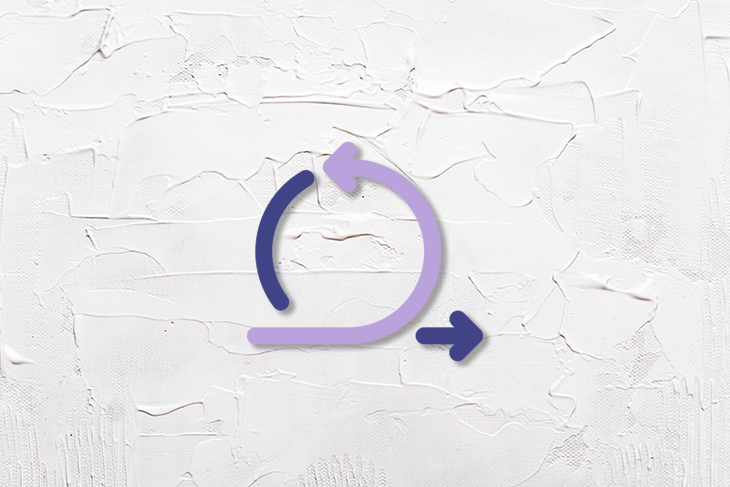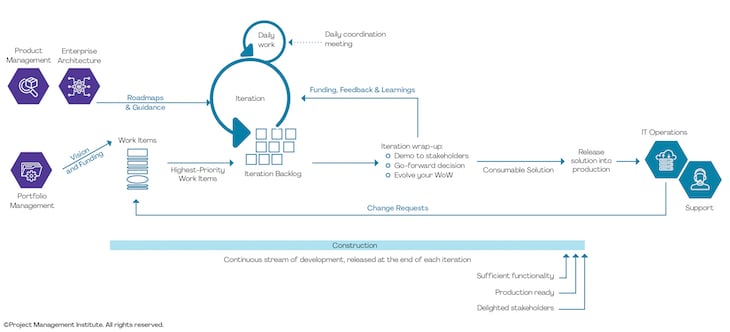In the vast landscape of agile frameworks, one size doesn’t fit all. Tech companies innovate and launch new agile frameworks every year to suit their unique needs.

Think of a construction site: while there are general guidelines all builders follow, each structure’s design and materials vary based on its purpose and the land it’s built upon.
Similarly, agile approaches like scrum, Kanban, and XP serve as reliable, tried-and-true guidelines, but they may fail to address all of the challenges and requirements of your specific project. This is where disciplined agile delivery (DAD) comes in.
Disciplined agile is a flexible agile method that adapts to any team’s needs rather than the other way around, where the team has to adapt to the practices of the framework.
Disciplined agile considers that every organization and team has its own culture, strengths, and areas of improvement. Instead of a rigid set of non-tailorable rules, DA offers a toolkit.
For example, whereas scrum teams operate in sprints and have daily standup meetings, a team using DA might find that holding biweekly sprints and thrice-a-week standups work better for them, given the nature of their project and team dynamics.
So, how does disciplined agile fit into the big agile picture? While many agile frameworks provide practices for specific parts of the delivery lifecycle, DA views the organization as a whole, acknowledging interconnected areas, from finance and sales, to governance, to product delivery.
Let’s take a real-life example: At a product-led company I worked at, we had a frequent-delivery manager who was proficient in scrum, but the team struggled when integrating marketing campaigns into its sprints, causing launches to fail and turning it into a feature factory team because of the team’s inability to communicate the updates to their end users. With DA, they could incorporate marketing processes smoothly, ensuring that, as the product was developed, product marketing deliverables would be ready to go, creating a cohesive product launch.
Disciplined agile about not replacing other agile methodologies but enhancing and adapting them. It’s like a master chef, taking ingredients from all agile practices from various cuisines (i.e., frameworks) and tailoring them to create a dish that perfectly suits the diner’s palate (your product team/organization).
The primary advantage of disciplined agile is that it gives you more breathing room than other agile frameworks. Specific benefits include:
DA champions flexibility, enabling product teams to make real-time adjustments and on-the-fly product enhancements.
Consider, for example, a mobile app development team that is focused on interface enhancements but identifies a security vulnerability midway through the sprint. Under scrum, they’d have to wait for the next sprint to address this. But with DA, they can immediately prioritize and rectify the security concern without waiting for the next sprint cycle.
Disciplined agile offers a panoramic perspective. A fintech startup using scrum might focus solely on features in its sprints. But with DA, they can concurrently align their app development with compliance and finance departments, ensuring that each iteration simultaneously adheres to regulatory standards and reducing the back-and-forth that might occur in more linear approaches.
DA recognizes the unique dynamics of each team. An e-commerce platform, if using a strict Kanban system, might face difficulties adapting to sudden changes. In contrast, with DA, they can introduce variable review periods, making their process more adaptive to the ever-changing nature of ecommerce demands.
DA emphasizes consistent evolution. Scrum might dictate post-sprint retrospectives for a cloud-based software provider, potentially delaying actionable insights.
With DA, they can host a retrospective after every software update, regardless of the sprint schedule, ensuring real-time adaptation and quick process development.
Disciplined agile is more accommodating, whereas traditional agile frameworks might be overly prescriptive.
For example, a marketing team at a burgeoning tech startup might find the rigidness of a framework like scrum challenging. Adopting DA would enable the team to start with fundamental agile practices and gradually expand as it grows more confident, adapting to immediate feedback without being tied to a strict sprint review.
To put this in context, I have engaged with disciplined agile, scrum, and SAFe companies before. The table below shows the major differences between the three major agile frameworks:
| DAD | Scrum | SAFe | |
| Roles | Flexible, based on the needs of the team and project | Fixed set of roles: Scrum master, product owner, developers | A more complex set of roles |
| Process flow | Iterative and incremental, with a focus on continuous delivery | Iterative and incremental, with a focus on delivering working software at the end of each sprint | Iterative and incremental, with a focus on delivering value to the business at the end of each program increment |
| Ceremonies | Adaptable, based on the needs of the team and project | Fixed set of ceremonies | More complex set of ceremonies |
| Artifacts | Flexible, based on the needs of the team and project | Fixed set of artifacts | More complex set of artifacts |
| Documentation | Flexible, based on the needs of the team and project | Less documentation | More complex documentation |
| Stakeholder involvement | Stakeholders are involved throughout the process, from inception to transition | Stakeholders are involved during sprint planning and sprint reviews | Stakeholders are involved throughout the process, from inception to transition |
| Ease of implementation | Can be complex to implement but is flexible and adaptable | Easy to implement but may not be as flexible or adaptable as DAD | Complex to implement but provides a comprehensive framework for scaling agile practices to large organizations |
| Maturity of agile practices | Can be used by organizations with any level of agile maturity | Best suited for organizations with some experience with agile practices | Best suited for organizations with a mature agile practice |
| Culture of organization | Can be used by organizations with any culture | Best suited for organizations with a collaborative and innovative culture | Best suited for organizations with a collaborative and innovative culture |
Disciplined agile is not a one-size-fits-all framework. Recognizing that different projects and organizations and even product teams have unique needs, DA offers a variety of lifecycles and configurations to match these requirements.
From “Continuous Delivery: Agile” to “Exploratory” and several in between, each version is tailored to cater to specific contexts and objectives. This flexibility ensures that teams can choose a path that aligns closely with their project’s nature while still benefiting from the structured guidance of the DA framework.
“Continuous Delivery: Agile” is the most popular and widely used delivery lifecycle under disciplined agile, and the one I’ve implemented most often:

It’s important to reiterate that this is not a fixed process like scrum; you can initiate any new ceremony or cycle that fits your organizational needs without having to stick to any rote framework:
This is where the team aligns on the vision of the project/product/major feature/or set of features. Team members identify high-level requirements, significant risks, and a preliminary plan. The team sets up its working environment during this phase.
The primary roles involved in this phase are the team lead, product owner, and team members. Secondary roles include the architecture owner and stakeholders.
Let’s look at an example. Suppose a company wants to revamp its existing ecommerce platform. The product owner presents the initial vision, emphasizing improved user experience and mobile-friendliness. High-level requirements — for instance, responsive design and intuitive search — are discussed. The architecture owner might flag a potential risk regarding integrating an older inventory management system.
During the construction phase, work is done in cycles called iterations, usually lasting two to four weeks (think of a cycle like a sprint). Each iteration involves analyzing, planning, designing, coding, and testing. User stories (requirements) are tackled one by one. Continuous integration tools help in automating parts of the development.
Let’s return to our example. In the second iteration, one of the features to be developed is the intuitive search feature for the newly developed platform. The team plans its design and development, codes it, and then tests it. By the end of the iteration, this feature is potentially shippable.
Roles involved in this phase include the team lead, product owner, team members, and, secondarily, the architecture owner, stakeholders, and integrators.
Once the team collaboratively feels the product (or a significant increment of it) is ready, it moves to the transition phase. This involves final testing, training (if necessary), and releasing the product to users. It’s also the phase where the team reflects on their process and identifies areas of improvement.
Back to our example: After several iterations, the ecommerce platform is deemed ready for a soft launch. The final tests are conducted, mainly focusing on mobile devices. Once released, the team gathers feedback. They also hold a retrospective meeting to discuss what went well and what didn’t during this cycle.
The Project Management Institute (PMI) offers a wide range of discipline agile certifications with different prices (starting at $350) and eligibility criteria. Some of these certifications include:
Disciplined agile delivery isn’t your DAD’s agile framework — it’s more of a toolset.
DA is flexible and can fit what any team might need. No matter your role — be it a team member, manager, or big boss — using DA can shift how you work on and share products. The trick is always to keep improving.
Featured image source: IconScout

LogRocket identifies friction points in the user experience so you can make informed decisions about product and design changes that must happen to hit your goals.
With LogRocket, you can understand the scope of the issues affecting your product and prioritize the changes that need to be made. LogRocket simplifies workflows by allowing Engineering, Product, UX, and Design teams to work from the same data as you, eliminating any confusion about what needs to be done.
Get your teams on the same page — try LogRocket today.

Most teams fail at autonomy. Learn how clear rules help product teams move faster without micromanagement.

A practical framework for PMs to use AI in ideation without sacrificing judgment, strategy, or decision quality.

A practical five minute revenue estimation method to help product managers compare ideas, drop low impact features, and prioritize smarter.

A practical guide for PMs who want to stop being bottlenecks, delegate smarter, and lead teams effectively with a clear ownership framework.
2 Replies to "What is disciplined agile delivery (DAD)? Overview with examples"
I thoroughly enjoyed reading your article! Your piece couldn’t have come at a better time for me; I recently took on the role of implementing DAD within my product team.
A very useful article and source for learning such high-quality information! I appreciate you sharing this useful information.